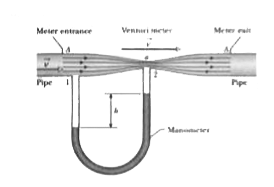The flow of blood in a large artery of an anesthetised dog is diverted through a Venturi Meter.The wider part of the meter has a cross-sectional area equal to that of the artery. A=8mm2. The narrow part has an area a=4mm2. The pressure drop in the artery is 24Pa. What is the speed of the blood in the artery?
We take the density of blood from table 10.1 to be 1.06×103kgm−3. The ratio of the areas is (Aa)=2 Using Eq.(10.17) we obtain
v1=√2×24Pa1060kgm−3×(22−1)=0.123ms−1
Topper's Solved these Questions
- MECHANICAL PROPERTIES OF FLUIDS BOOK - NCERT GUJARATICHAPTER - MECHANICAL PROPERTIES OF FLUIDS EXERCISE - EXERCISE
31 Videos
- LAW OF MOTIONBOOK - NCERT GUJARATICHAPTER - LAW OF MOTIONEXERCISE - EXERCISE (ADDITIONAL EXERCISE)
17 Videos
- MECHANICAL PROPERTIES OF SOLIDS BOOK - NCERT GUJARATICHAPTER - MECHANICAL PROPERTIES OF SOLIDS EXERCISE - Exercises
16 Videos
Similar Questions
The flow of blood in a large artery of an anesthetised dog is diverted through a venturimeter. The wider part of the meter has a cross-sectional area equal to that of the artery, A=16mm2. The narrower part has an area a=9mm2. The pressure drop in the artery is 24 Pa. What is the speed of the blood in the artery ?
View SolutionThe flow of blood in a large artery of an anesthetised dog is diverted through a venturimeter. The wider part of the meter has a cross-sectional area equal to that of the artery, A=16mm2. The narrower part has an area a=9mm2. The pressure drop in the artery is 24 Pa. What is the speed of the blood in the artery ?
View Solution
Knowledge Check
The flow of blood in a large artery of a anesthetized dog is diverted through a venturimeter. The wider part of the meter has a cross-sectional area equal to that of the artery A = 10mm2. The narrower part has an area a = 5mm2. The pressure drop in the artery is 22Pa. Density of the blood is 1.06×103kgm−3. What is the speed of blood in the artery?
A0.12ms−1B0.62ms−1C0.24ms−1D0.42ms−1The flow of blood in a large artery of a anesthetized dog is diverted through a venturimeter. The wider part of the meter has a cross-sectional area equal to that of the artery. Ie., 10mm2 . The narrower part has an area 5mm2. The pressure drop in the artery is 22Pa. Density of the blood is 1.06x10 (3)kg m^(-3). The speed of the blood in the artery is
A0.12ms−1B0.62ms−1C0.24ms−1D0.42ms−1
The flow of blood in a large artery of an anaeshetized dog is diverted through a venturimeter. The wider part of the meter has a cross sectional area equal to that of the artery i.e. 8mm2. The narrower parts has an are 4mm2. The pressure dorp in the artery is 24Pa. what is the speed of the blood in the artery ? Given that density of the blood = 1.06×103kg/m3
View SolutionThe flow of blood in a large artery of an anaeshetized dog is diverted throg]ugh a venturimeter. The wider part of the meter has a cross sectional area equal to that of the artery i.e. 8mm2. The narrower parts has an are 4mm2. The pressure dorp in the artery is 24Pa. what is the speed of the blood in the artery ? Given that density of the blood = 1.06×103kg/m3
View SolutionConsider the flow of blood, whose density is 1.06×103kgm−3, in a large artery of an anesthetised Alsatian which is diverted through a venturi meter. The area of cross-section of both the wider part of the meter and that of the artery is 12mm2 and the narrower part has an area of 6mm2. If the pressure drop in the artery is 20 Pa, then the speed of the blood in the artery is 1.10×10−xm/s. Now, what is x = ? (Take the density of the blood is )
View SolutionThe current density (to J) at cross-sectional area (to A = (2ˆi+4ˆj)(mm2) is (2ˆj+2ˆk)A /(m2). The current flowing through the cross-sectional area is
View SolutionThe current density (J) at cross-sectional area (A=(2ˆi+4ˆj)mm2) is (2ˆj+2ˆk)A/m2. The current flowing through the cross-sectional area is
View SolutionA venturi meter is used to measure the flow speed of a fluid in a pipe . The meter is connected between two sections of the pipe (Fig) the cross-sectional area A of the entrance and exit of the meter matches the pipe's cross-sectional area a with speed v . A manometer connects the wider portion of the meter to the narrower portion . The change in the fluid's speed is accompanied by a change Δp in the fluid 's pressure , which causes a height difference h of the liquid in the two arms of the manometer. (Here , Δp means pressure in the throat minus pressure in the pipe).

Suppose that the fluid is fresh water , that the cross-sectional areas are 64cm2 in the pipe and 32cm2 in the throat , and that the pressure is 55 kPa in the pipe and 41 kPa in the throat , and that the pressure is 55 kPa in the pipe and 41 kPa in the throat . What is the rate of water flow in cubic meters per second ?
View Solution
